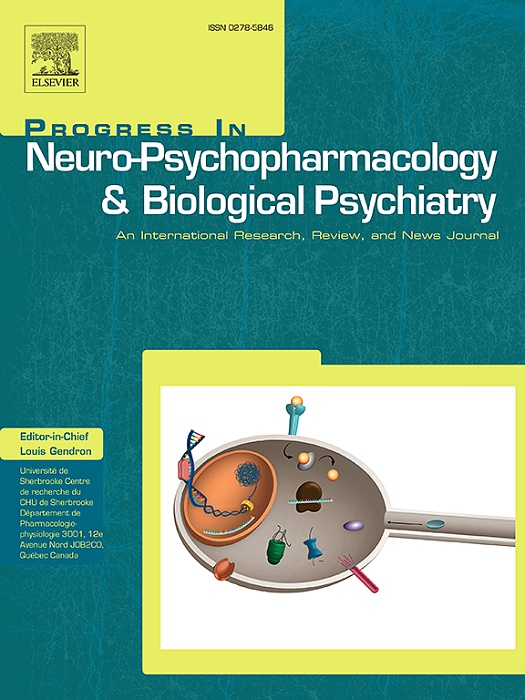未治疗精神病的持续时间与首发抗精神病药物无效精神分裂症患者的认知功能:来自听觉P300的证据
IF 3.9
2区 医学
Q1 CLINICAL NEUROLOGY
Progress in Neuro-Psychopharmacology & Biological Psychiatry
Pub Date : 2024-11-22
DOI:10.1016/j.pnpbp.2024.111202
引用次数: 0
摘要
目的:精神分裂症(SZ)患者未经治疗的精神病持续时间(DUP)与认知功能之间的关系仍存在争议,事件相关电位(ERP)研究没有实证证据支持两者之间的关系。本研究旨在利用ERP研究首次发病的抗精神病药物无效的精神分裂症(FEAN-SZ)患者的DUP与认知功能以及精神症状之间的关系:研究纳入了321名中国FEAN-SZ患者和146名健康对照者。收集了所有参与者的 DUP 和社会人口学特征,并使用阳性和阴性综合征量表评估了精神症状。结果显示:25.5%的患者四年以上未接受及时治疗,教育程度较低或阴性症状较严重的患者DUP时间较长(P = 0.027,P = 0.020)。与健康对照组相比,FEAN-SZ 患者的 P3 分量潜伏期较长,振幅较低(所有 ps 均为 48 个月组 (β = -0.228, p = 0.040)。多元线性回归分析表明,P3a 的潜伏期和振幅与 DUP 独立相关(B = 0.124,p 结论:P3a 的潜伏期和振幅与 DUP 无关:DUP时间较长的SZ患者表现出更严重的P3缺陷,P3分量可能表明不同时间的DUP中精神症状的严重程度不同,P3a分量也可作为评估DUP时间长短的电生理标记。本文章由计算机程序翻译,如有差异,请以英文原文为准。
Duration of untreated psychosis and cognitive function in first-episode antipsychotic-naïve schizophrenia: Evidence from auditory P300
Objective
The relationship between the duration of untreated psychosis (DUP) and cognitive function in schizophrenia (SZ) patients remains debated, with no empirical evidence from event-related potential (ERP) studies supporting their association. This study aims to investigate the relationship between DUP and cognitive functions, as well as psychiatric symptoms, in first-episode antipsychotic-naïve SZ (FEAN-SZ) patients using ERP.
Methods
The study included 321 Chinese FEAN-SZ patients and 146 healthy controls. The DUP and sociodemographic characteristics of all participants were collected, and psychiatric symptoms were assessed using the Positive and Negative Syndrome Scale. The P300 (P3) components, including P3a, P3b and N100, were recorded from all participants using auditory oddball paradigm.
Results
25.5 % of patients did not receive timely treatment for over four years, and those with lower educational levels or more severe negative symptoms had longer DUP (p = 0.027, p = 0.020). Compared to healthy controls, FEAN-SZ patients exhibited longer latencies and lower amplitudes in the P3 components (all ps < 0.001). Significant differences in the P3 components were observed among three groups of DUP (< 8 months, 8 to 48 months, and ≥ 48 months) (all ps < 0.001). In the 8 ≤ DUP < 48 months group, the N1 amplitude and P3a latency predicted positive symptom scores and general psychopathology scores, respectively (β = −0.165, p = 0.037; β = 0.541, p < 0.001); P3b latency predicted negative symptom scores in the DUP < 8 months group (β = 0.391, p < 0.001). N1 amplitude predicted general psychopathology scores only in the DUP > 48 months group (β = −0.228, p = 0.040). Multiple linear regression analysis indicated that the latency and amplitude of P3a were independently associated with DUP (B = 0.124, p < 0.001; B = −1.161, p = 0.012).
Conclusions
SZ patients who have a longer DUP exhibit more severe P3 deficits, and the P3 components may be indicative of different psychiatric symptom severity in DUPs of different lengths, as well as the P3a component may serve as an electrophysiologic marker to assess the length of DUP.
求助全文
通过发布文献求助,成功后即可免费获取论文全文。
去求助
来源期刊
CiteScore
12.00
自引率
1.80%
发文量
153
审稿时长
56 days
期刊介绍:
Progress in Neuro-Psychopharmacology & Biological Psychiatry is an international and multidisciplinary journal which aims to ensure the rapid publication of authoritative reviews and research papers dealing with experimental and clinical aspects of neuro-psychopharmacology and biological psychiatry. Issues of the journal are regularly devoted wholly in or in part to a topical subject.
Progress in Neuro-Psychopharmacology & Biological Psychiatry does not publish work on the actions of biological extracts unless the pharmacological active molecular substrate and/or specific receptor binding properties of the extract compounds are elucidated.

 求助内容:
求助内容: 应助结果提醒方式:
应助结果提醒方式:


